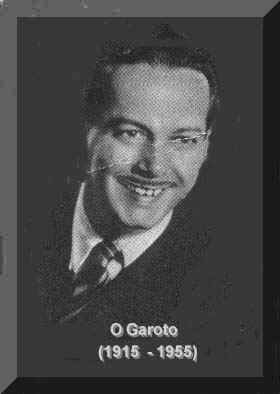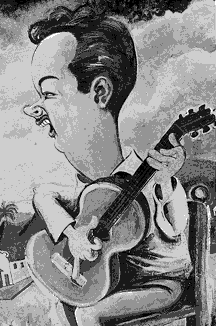| Garoto | ||||||||||||||||||||||
| Anibal Augusto Sardinha | ||||||||||||||||||||||
.gif)



|
Infernal Amor Indiferenca Gente Humilde Dolente Enigma Nosso Choro Sonhador Choro Triste no.2 Doce Lembranca Caramelo Desvairada Choro Triste no.1 Trapalhadas do "Garoto" Meditando Eu Comprei uma Ilusao Sao Paulo Quatrocentao Despedida Aqui Estou Meu Cavaquinho Nao e' Sopa Relampago Ver Para Crer | |||||||||||||||||||||
| "The Kid With the Banjo" | ||||||||||||||||||||||
|
Like sacred images in religious households , photographs of Garoto decorate the walls of the homes of Brazilian guitarists . To them , these photographs emanate inspiration and encouragement from the man who was the single most potent source of influence on Brazilian guitar-playing . Baden Powell , Luis Bonfa , Raphael Rabello , among others , confirm at every opportunity their infinite debt and gratitude to this vastly talented musician , who died so prematurely at the age of 39 on the 3rd of May 1955 from a heart attack . His position in the hearts of brazilian musicians is similar to that of Charlie Parker among jazz musicians or Dinu Lipati in the classical field . Anibal Augusto Sardinha , or Garoto as he is now known , was born on June 29 1915 , in S. Paulo . Both his parents were Portuguese , and his father and brothers were all able players of the Portuguese guitar . Anibal soon showed the fabulous natural talent of a child prodigy . At the age of 11 , when performing at the Teatro Santa Helena , the programme announcer soon tired of having each time to say the long name of this young boy , and called him "Garoto do Banjo" , which in Portuguese means simply "The Kid With the Banjo" . The instrument with which he began his career was the banjo , but by the age of 16 he played with equal facility the mandolin , the tenor guitar , the cavaquinho (a kind of mandolin) , the Hawaiian guitar and , of course , the guitar . Yet this nickname , so casually given , describes ironically his hole being and behaviour . When I recently read his diary , lent to me by Dona Ceci (his companion during his last years) , I was both surprised and touched by the simplicity , sincerity and directness of his meditations ."Bonfa I can trust" , is still , after nearly five decades , the pride of Luis Bonfa , who pointed it out to me in the diary . Today it is quite irrelevant to recount his life in much detail . Even in Brazil , most of the names of those involved are half-forgotten . The life of an instrumentalist , even of the most accomplished , was , and still is , one of extraordinary hardship . To make ends meet , Garoto was forced to take several jobs ; not infrequently playing in cabarets until the early morning ; then going to another job after only two or three hours' sleep . Everyone tried to get a job at a radio station which , because of its popularity , could provide the much-needed publicity to its instrumentalists . They could then perform in shows , night clubs and recording sessions for much better pay than the miserable salaries offered by the radio stations . A solo career was impossible ; the guitar was not a "respectable" instrument . Garoto worked almost continuously for several different radio stations : first in S. Paulo (Radio Educadora and Radio Cosmos); then in Rio (Radio Mayrink Veiga)- and finally in 1942 for Radio Nacional , where he was to stay virtually continuously until 1954 . It was there that Garoto met the composer Radames Gnattali . A friendship flowered between these two men which on the national level was to become for the development of the guitar in Brazil as important as the friendship between Segovia and Villa-Lobos on the international level . While still in S. Paulo Garoto had worked in duo : first with Canhoto (a very important left-handed guitarist) , then with Aimore (with whom he performed for the first time in Brazil , the four-handed duet on one guitar so popular now) ; and finally - a particularly close association - with Laurindo Almeida , playing in several ensembles in their duo "Garoto and Laurindo" . Laurindo was to be the first to record Garoto's own music outside Brazil , and was given three Choros which the author considered his best , for publication . The difference in his association with Gnattali was that here he was in front of a concert pianist of immense musical knowledge ; yet who was also totally open to Garoto's ambititions and specific talents which , ultimately , lay in his improvisational ability and in the Choro . So many of Garoto's compositions are truly improvisations : "Improviso" , "Prelude" , "Um Rosto de Mulher" , "Nosso Choro" , etc. Baden Powell's statement that "improvisation and composition are twin sisters " , is true for Garoto's music as a whole . It was Gnattali who pointed Garoto towards the study of modern guitar composers (like Ponce) and to Bach . It was Gnattali who said it was "all right" to play with all five fingers of the right hand . Many of Gnattali's compositions like the "Toccata em Ritmo de Samba" (Concert Study no.2) and his "Guitar Concerto no.2" where composed at Garoto's wish : the Concerto for a performance at the Teatro Municipal - the most prestigious Concert Hall in Brazil - conducted by the eminent Eleazar de Carvalho . Garoto's immense talent as instrumentalist and composer had total resonance with Gnattali : the need to create a repertoire with popular Brazilian roots yet with the technical complexity of contemporary classical music . The guitarist Antonio Carlos Barbosa-Lima has been for decades following the same aesthetic orientation through his very difficult and beautiful transcriptions of Brazilian popular music . Garoto was a great improviser and while playing his own works would constantly introduce new modifications to his listeners . The survival of the main body of Garoto's music is wholly due to that most admirable of men , Mr. Ronoel Simoes , who has dedicated his entire life to the guitar and over 50 years has assembled one of the most complete collections of guitar recordings and scores - and certainly of Brazilian music - in the world . It was Mr. Simoes who invited Garototo his home , and it was for him that Garoto in 1950 recorded privately 13 of his own hitherto unpublished and unrecorded compositions , including most of his Choros . Yet Mr. Simoes told me that he only recorded one version of the several proposed by Garoto . From these private tapes belonging to Mr. Simoes , the guitarist Geraldo Ribeiro , 25 years after the composer's death , transcribed and published the complete works of Garoto , with Arlequim in S. Paulo in 1980 . He also recorded the first-ever record devoted to Garoto's compositions . All credit for resurecting the work of Garoto must without doubt therefore go to Ronoel Simoes and the admirable efforts made by Geraldo Ribeiro . Any future publication of the work of Garoto would have to duplicate Geraldo Ribeiro's steps and go back to Ronoel Simoes' tapes which , however important , were never meant as the definitive versions for posterity , but simply a spontaneous gift to a friend who wished to have previously unrecorded material . Gennady Zalkowitsch London , October 1990
| Puxa-Puxa Pingo de Ouro Vamos Acabar Com o Baile Moreninha Gracioso Voltarei Quanto Doi uma Saudade Dugenir
|
Favorite Links
|
|
| ||||||||||||||||||
|
This page has been visited
|


